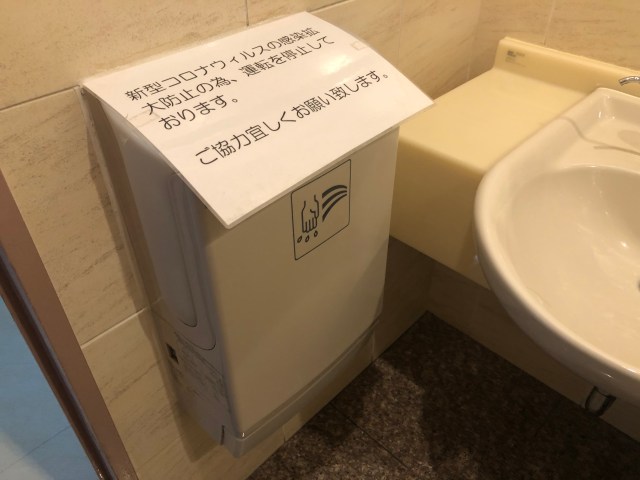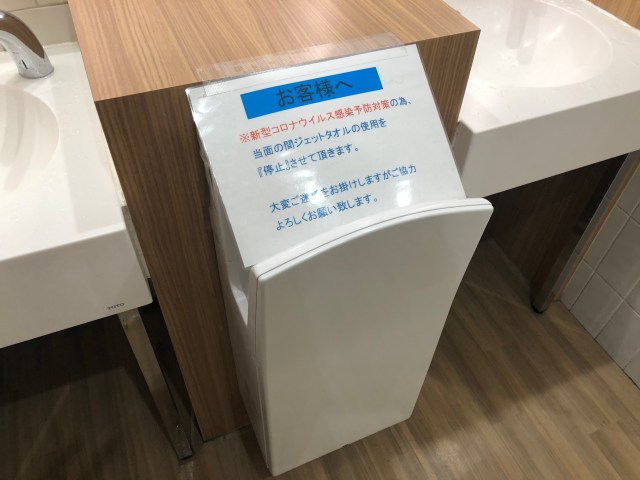
New study fears shutting them down might do more harm than good.
As we have often seen over the past year-and-a-half, every country has their own way of dealing with the threat of COVID-19. Japan has largely allowed business to continue, albeit with certain restrictions, in an effort to balance safety with maintaining the economy.
Whether this relatively lax approach was the right move is open for debate, but an interesting detail of it all was that, very early on into the pandemic, Japan swiftly shut down most, if not all, automatic hand dryers with extreme prejudice. In what seemed like the blink of the eye, every air dryer in sight was unplugged and taped over.
▼ Laminated placards typically serve a double purpose of apologizing for the inconvenience and providing an iron wall of security into the belly of the drying beast

Even before this coronavirus reared its ugly head, there had been a lot of debate over the hygiene of these contraptions. Opponents claim that they tend to suck in the impure restroom air that has been tainted with the mist of flushed toilets. However, studies have been conflicting on the overall effects of that, which suggests it largely depends on the type of machine and type of microorganism being dealt with.
Still, most would agree that shutting them down in the face of this then-unknown threat was a prudent move. Days then turned to weeks and weeks turned to months and now I can hardly remember what those obnoxiously loud boxes sound like anymore.
▼ Ah yeah… That takes me back.
It looks like that’s all about to change though, because on 12 April the Japan Business Federation has revised its Novel Coronavirus Infection Prevention Guidelines. As a part of their efforts to keep up with the changing times, they have lifted their embargo on hot air and are asking offices, factories, and commercial facilities to turn the dryers back on.
The federation commissioned a study on the matter with the Hygiene & Microbiology Research Center in Tokyo and found no increase in the amount of bacteria around the sections where hands are dried.
In addition, other experts have cited the number of COVID-19 infections traced back to public restrooms are “extremely” small, meaning the risk of a dryer-borne infection is also low. Not only that, but with no dryers it is feared that some people aren’t washing their hands properly – or at all – which increases the risk of viral transmission.
Naturally, with such a divisive machine, public opinion on the lifted ban was all over the map.
“So, why did they stop using it without any scientific basis in the first place?”
“Thank you! I’ve been having to wipe my hands on my pants like I did in grade school.”
“We got everyone using cloth bags, why not handkerchiefs too?”
“The place I usually go installed paper towels instead. I kind of hope they keep it that way.”
“Frankly, I’d be more worried about the toilet seat than the hand dryer.”
“It’s more dangerous to brush your teeth in those places but I still see people doing that.”
“Eh, I never used them anyway.”
“Those things don’t even get your hands dry anyway.”
“I just wish they put the whole setup outside. I hate having to wash my hands and then touch the same door that people who don’t wash use.”
The last comment would seem to have hit the crux of the matter–a bigger threat could well be the door which is shared by hand washers, quick rinsers, and the sullied alike. Also, installing the dryer outside of the germy restroom air would help clear up a lot of the concerns about them.
But that kind of renovation would be a tall order for most places, so I’ll be sticking to trying to guess which part of the door handle is least touched by others and to using my handkerchief. Those little cloths have really grown on me and make me look like a right dandy.
Source: The Sankei News, My Game News Flash
Photos ©SoraNews24
● Want to hear about SoraNews24’s latest articles as soon as they’re published? Follow us on Facebook and Twitter!

No hay comentarios:
Publicar un comentario